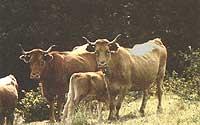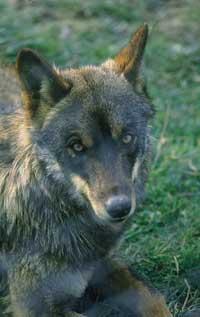BETIZUA, local livestock in danger of extinction
1996/02/01 Elosegi Irurtia, Migel M. Iturria: Elhuyar aldizkaria
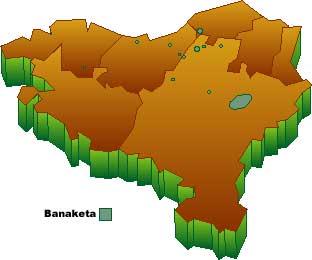
I never felt excited about the cows. Nor when running the bulls in the patron saint festivities. But that was not for less! Lying on the ground, looking with binoculars, we looked at the elegant group of betizu. However, those copulosos, who climb the steep, soon hide us in the forest. Seeing that those wild cows had escaped us, I thought of the name of Brava cow or betizu. But I also came up with something else: What would you say if a Basque pastor a few years ago had seen a group of veterinarians, biologists and naturalists like us, surprised by customs? Who knows! But more surprising than seeing us in that situation, is that the betizu are in danger of extinction.
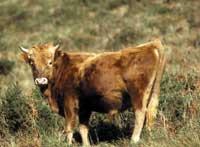
The origin of these animals is undoubtedly very old and it seems to be found in the populations of the wild bovids that formerly inhabited the Pyrenean area. Isolated by the mountainous relief, the betizu race remained uncrossed with other races, so we could say that it is the one that has lasted from the ancient populations. As we shall see, all the characteristics of these mammals are typically primitive: the unimproved mountain cattle breeds. The most outstanding features are:
For starters, they have a small size: Only 1,20-1,30 meters high above the body and 250-350 kilos of weight. The body is slender, with the front stronger than the rear. Thick neck, thin head, long end and white rabbit. The forehead is hairy and flat. As for the branches, they are of medium size, in the form of lyre or “c”. They also highlight the straight back, the intestinal buttocks and the high peak tail. Its legs are medium in size and its hooves are small. A small hairy grape without pigmentation. The leather is finally hairy and red or brown-reddish.
They have a surprising ear and a very fine smell. When they are on the mountain, they escape if they feel human. In the enclosures, however, they can resist and therefore have been used for games in the squares. Because of this incendiary character, the shepherds had a hard work of government and gathering. In fact, in the shakes that were made to mark the betizu or to catch their offspring, diapers were used. These catches were normally done once a year, with the rest, including winter, in the wild, on the mountain. However, for this way of life there are adapted inventions that can also graze in pastures and shrubs of low quality. In addition, like the great wild herbivores, throughout the year they exploit different areas in search of the most suitable pastures.
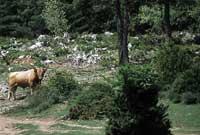
In turn, reproduction is associated with the seasons of the year and although they do not grow each year, they can do so without help. The male that has been imposed in the fights of Araldi is the one that covers the group of females. The female is separated from the group to give birth in a quiet place. That is the most dangerous time to approach these animals, as their mother can easily attack.
They have been used mainly for meat, as their use at work was difficult. Expert butchers consider that one of the best butchers is the most veal of the betizu breed, but other beef breeds provide more meat, so they have crossed with them or simply replaced. Today's Pyrenean cow is also responsible for these blends. Consequently, as the cows of Switzerland and Holland have grown in recent years, this breed has suffered a strong setback.
Therefore, unfortunately the conservation status of betizu is critical. Currently there are about 200 specimens distributed in different groups. The strongest and most wild population is located on the grounds of the Government of Navarra, in the mountains of Zarikieta and Artxuba. This section was introduced by the group ANAN (Naturalists of Navarra) in their effort to preserve that cattle. In addition to this population of 50-70 individuals, there are other places where betizus are found, such as Dima, Goizueta, Leitza, Olague, Baraibar, Baztan-Bidasoa, Itziar, Berastegi and Sara. Although in these places there are betizus, most are mixed and few are clean. But someone may ask... and why should we protect the old small cow, panic and brutish that gives less meat and milk?
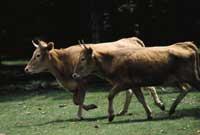
There are many reasons. To begin with, it is ours, and nowhere else will we find something similar. It is a cultural heritage that has come to us from previous generations and that descendants also have the right to know it. It is also genetically interesting. They are adapted to the climate and local food, are resistant and resistant to changes in the environment, can live in impoverished areas and have resistance to diseases. Who knows today if these genetic resources can be important in the future? It should be noted that the Basque landscape and ecosystems are important and that in very few places this type of wild bovids can be found. In addition, when promoting the protection of this species, we could promote other species.
The current situation demands immediate measures to ensure its conservation. Among the measures that should be taken, it should be noted the quantification and protection of all existing specimens and the subsidy to the shepherds, the exhaustive knowledge of this race, the program of recovery and the planning of the territory in order to live in the mountain. The danger of extinction of this breed has led to the creation of the Association of Friends of the Betizu, dedicated to the research, conservation and conservation of the betizu. Bejondeiela to all who have bet and work forever! In any case, this magnificent animal will also need the support of the Administration and society if we want the next generations to know it.
Species: Bos taurus turdetanus |

Gai honi buruzko eduki gehiago
Elhuyarrek garatutako teknologia



